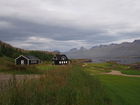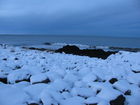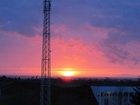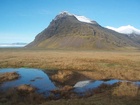Articles

The weather in Iceland 2015
The weather in 2015 was considered unfavourable, except the autumn. The winter was dominated by a series of heavy windstorms, often with snow and rain. In late April, cold and northerly winds set in and persisted until the end of August, often with heavy precipitation in the Northeast and East, but in the Southwest the weather was slightly more favourable. The autumn (September to November) was the most favourable part of the year. The year 2015 was the coldest in Iceland since 2000, but this period has generally been abnormally warm so the average temperature was close to the 1961-1990 mean. In most parts of the country, the precipitation was well above normal.
Read more
Final Conference of the SVALI project
The Final Conference of the Nordic Center of Excellence SVALI was held 4-5 June at the Ilulissat Climate Days in Greenland, focusing on the topics of changes of the Arctic and North-Atlantic land ice as well as glacier and ice cap changes, process understanding and impacts on sea level.
The Ilulissat Climate Days especially address recent, ongoing and future changes in the ice in and around Greenland, with a special focus on the effects for the Greenland society.
Read more
The weather in Iceland 2014
The year 2014 was very warm, precipitation was abundant and the sunshine duration during most of the summer was considerably below average.
In spite of the high temperatures the weather was changeable and often dull.
The first months of the year were especially wet in the North and East and the weather was difficult. In the west it was very dry at the same time with favourable weather conditions.
The summer was warm and considered fine in the North and East but in the south it was very wet and dull.
The autumn was fine, November extraordinarily warm, but the year ended with an unruly and rather cold December.
Read more
Climate change and hydrology: Environmental and societal effects
The climate and hydrology of Iceland are highly variable due to natural conditions. Significant changes in these factors over the last 15 years are in harmony with the future scenarios represented and affirmed in the latest IPCC summary report, AR5. The main purpose of IMO is to contribute towards security in society by monitoring, analyzing, interpreting, informing; providing warnings and forecasts and predicting natural hazards. It is important to keep the infrastructure strong so that IMO may fulfill its role.
Read more
The weather in Iceland 2013
The weather in Iceland in 2013 was mainly favorable, however, the spring was harsh in the North and East and the summer was on the dull side in the South and West, with precipitation and cloudiness above average. This was the dullest summer of the new century in this area of the country.
The temperature was unusually high during the first two months but for the rest of the year it was closer to the 1961 til 1990 average.

The weather in Iceland 2012
On the whole the year was a favorable one. However, the first three months were dominated by very changeable and windy weather and southerly and westerly winds that eventually became quite mild. A few damaging windstorms hit the country. September and November were dominated by unfavorable weather.
Read more
The weather in Iceland 2011
The year 2011 was warm and the weather mainly favorable in Iceland except for a bad cold spell in late May and June. April and November were unusually warm. At a few stations in the east and northern coastal areas April was warmer than June. This has not happened before in Iceland at any station since the beginning of instrumental recording.
Read more
The weather in Iceland 2010
The weather in Iceland was highly unusual in 2010. This applies especially to the South and West parts of the country where the year was one of the warmest and driest on record and the snowfall was unusually light. The barometric pressure reached the highest annual value on record. The climate was very favourable and windstorms markedly fewer than usual.
Read more
The weather in Iceland 2009
The weather was very favourable in Iceland in 2009. The temperature was well above the 1961 to 1990 mean. This was the driest year in Reykjavík since 1995, but the wettest in Akureyri since 1991.
Read more
The weather in Iceland 2008
The weather was favourable in 2008. The summer half of the year, May to September was unusually warm in the South and West. October was the only cold month of the year.
Read more
Past temperature conditions in Iceland
This has been a period of a general rise in temperatures, interrupted by two cold periods. The late 19th century cold period was colder than a corresponding period in mid to late 20th century.
Read more
The weather in Iceland 2007
During 2007, warmer conditions that have prevailed since 2000 dominated again.
Read moreThe weather in Iceland 2006
The year was generally favourable and warm. In the South and West the temperature was about 1.1°C above the 1961-1990 normal and 1.3 to 1.8°C above normal in the North and East. The average temperature in Reykjavik was 5.4°C. It ranks as the eleventh warmest year in Reykjavik since the inception of continuous measurements there, in 1870.
Read more
Early work and an overview of measurements
Evaluation of the history of climate in Iceland since the settlement has been ongoing for more than two hundred years. Hannes Finnsson, the bishop of Skálholt wrote the first scientific treatise on the subject in 1796 (Finnsson, 1796).
Read moreThe weather in Iceland 2005
The weather was on the whole favourable, but less settled than during the previous three years. The temperature was above the 1961-1990 normal, about 0.7 to 0.9°C in most areas, but 0.3 to 0.6°C in the Southeast.
Read more


